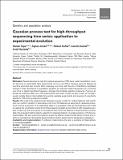Files in this item
Gaussian process test for high-throughput sequencing time series : application to experimental evolution
Item metadata
| dc.contributor.author | Topa, Hande | |
| dc.contributor.author | Jónás, Ágnes | |
| dc.contributor.author | Kofler, Robert | |
| dc.contributor.author | Kosiol, Carolin | |
| dc.contributor.author | Honkela, Antti | |
| dc.date.accessioned | 2017-02-09T13:30:21Z | |
| dc.date.available | 2017-02-09T13:30:21Z | |
| dc.date.issued | 2015-06-01 | |
| dc.identifier | 249098690 | |
| dc.identifier | ea59bf6e-c324-4200-b2f2-1d360c02bd11 | |
| dc.identifier | 25614471 | |
| dc.identifier | 84941687465 | |
| dc.identifier.citation | Topa , H , Jónás , Á , Kofler , R , Kosiol , C & Honkela , A 2015 , ' Gaussian process test for high-throughput sequencing time series : application to experimental evolution ' , Bioinformatics , vol. 31 , no. 11 , pp. 1762-1770 . https://doi.org/10.1093/bioinformatics/btv014 | en |
| dc.identifier.issn | 1367-4803 | |
| dc.identifier.other | PubMedCentral: PMC4443671 | |
| dc.identifier.uri | https://hdl.handle.net/10023/10258 | |
| dc.description | The work was supported under the European ERASysBio+ initiative project ‘SYNERGY’ through the Academy of Finland [135311]. A.H. was also supported by the Academy of Finland [259440] and H.T. was supported by Alfred Kordelin Foundation. R.K. was supported by ERC (ArchAdapt). A.J. is member of the Vienna Graduate School of Population Genetics which is supported by a grant of the Austrian Science Fund (FWF) [W1225-B20]. | en |
| dc.description.abstract | MOTIVATION: Recent advances in high-throughput sequencing (HTS) have made it possible to monitor genomes in great detail. New experiments not only use HTS to measure genomic features at one time point but also monitor them changing over time with the aim of identifying significant changes in their abundance. In population genetics, for example, allele frequencies are monitored over time to detect significant frequency changes that indicate selection pressures. Previous attempts at analyzing data from HTS experiments have been limited as they could not simultaneously include data at intermediate time points, replicate experiments and sources of uncertainty specific to HTS such as sequencing depth. RESULTS: We present the beta-binomial Gaussian process model for ranking features with significant non-random variation in abundance over time. The features are assumed to represent proportions, such as proportion of an alternative allele in a population. We use the beta-binomial model to capture the uncertainty arising from finite sequencing depth and combine it with a Gaussian process model over the time series. In simulations that mimic the features of experimental evolution data, the proposed method clearly outperforms classical testing in average precision of finding selected alleles. We also present simulations exploring different experimental design choices and results on real data from Drosophila experimental evolution experiment in temperature adaptation. AVAILABILITY AND IMPLEMENTATION: R software implementing the test is available at https://github.com/handetopa/BBGP. | |
| dc.format.extent | 9 | |
| dc.format.extent | 635024 | |
| dc.language.iso | eng | |
| dc.relation.ispartof | Bioinformatics | en |
| dc.subject | Alleles | en |
| dc.subject | Animals | en |
| dc.subject | Drosophila | en |
| dc.subject | Gene frequency | en |
| dc.subject | Genomics | en |
| dc.subject | High-throughput nucleotide sequencing | en |
| dc.subject | QH301 Biology | en |
| dc.subject | QH426 Genetics | en |
| dc.subject | DAS | en |
| dc.subject | BDC | en |
| dc.subject | R2C | en |
| dc.subject.lcc | QH301 | en |
| dc.subject.lcc | QH426 | en |
| dc.title | Gaussian process test for high-throughput sequencing time series : application to experimental evolution | en |
| dc.type | Journal article | en |
| dc.contributor.institution | University of St Andrews. School of Biology | en |
| dc.contributor.institution | University of St Andrews. Centre for Biological Diversity | en |
| dc.identifier.doi | 10.1093/bioinformatics/btv014 | |
| dc.description.status | Peer reviewed | en |
This item appears in the following Collection(s)
Items in the St Andrews Research Repository are protected by copyright, with all rights reserved, unless otherwise indicated.

